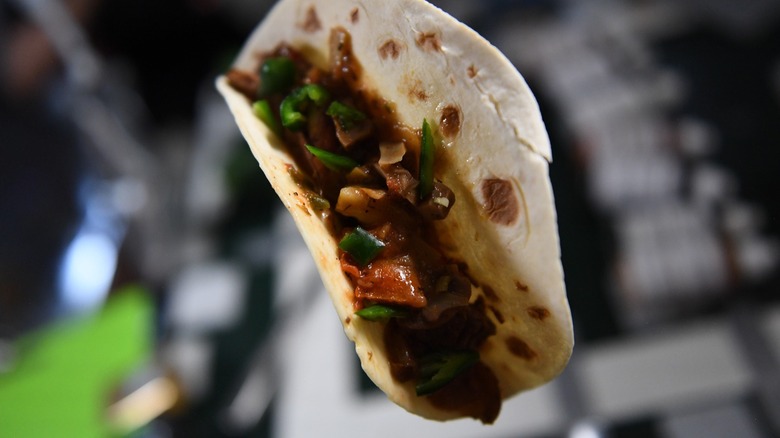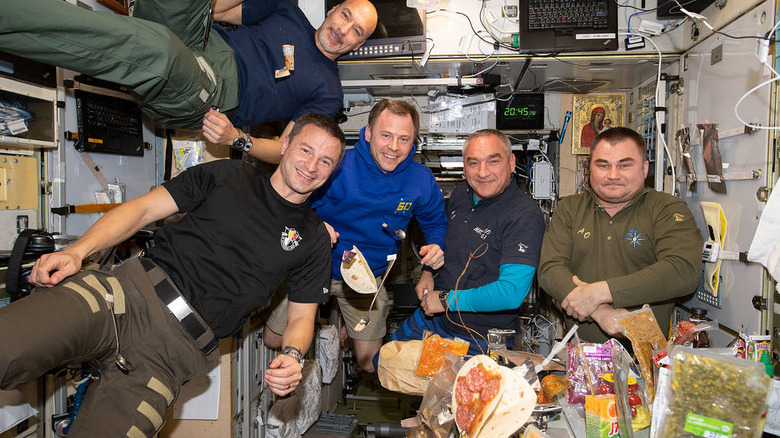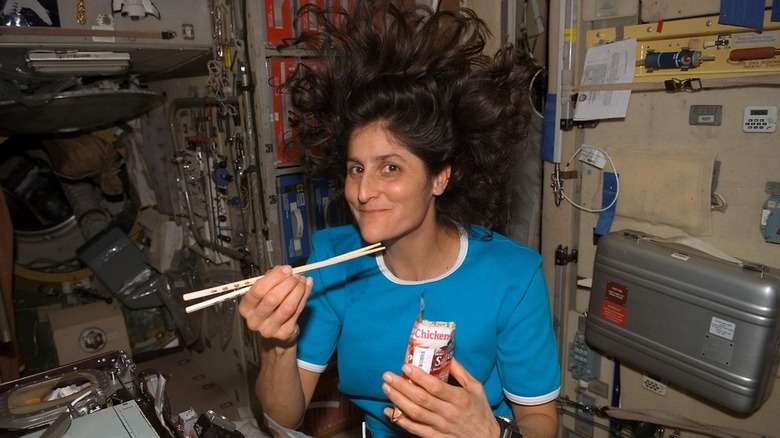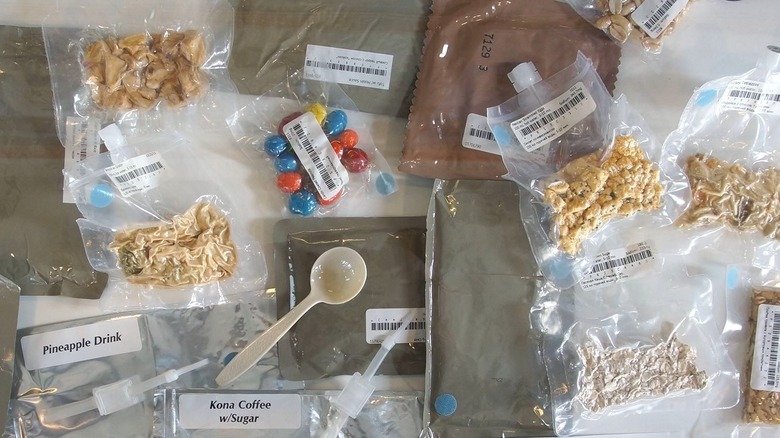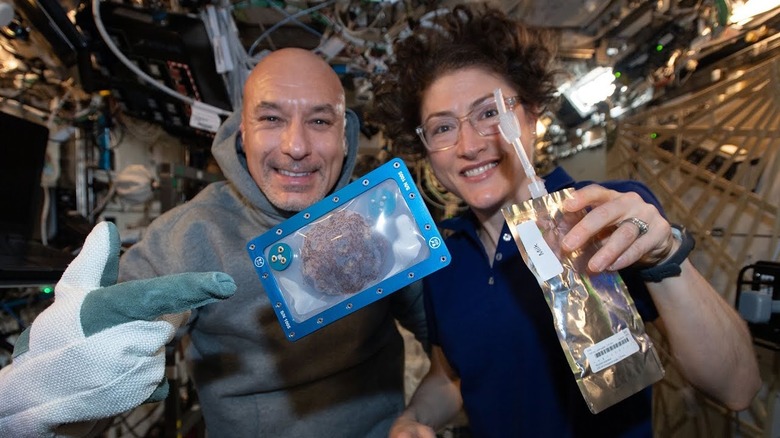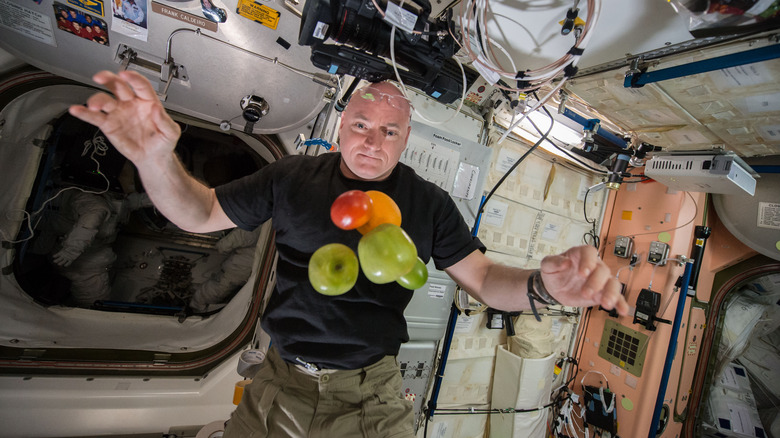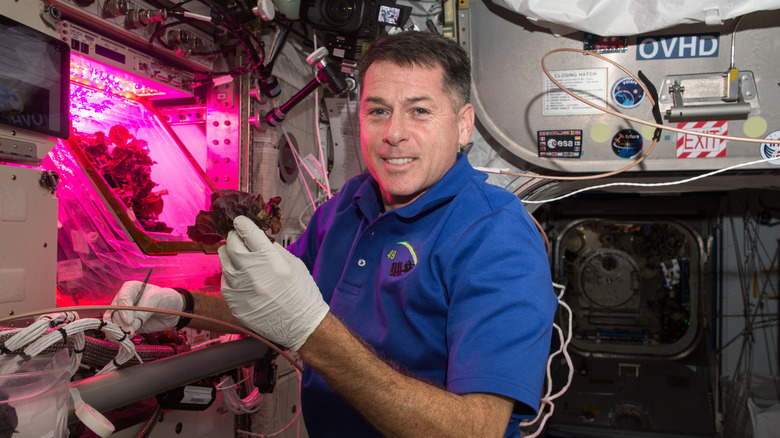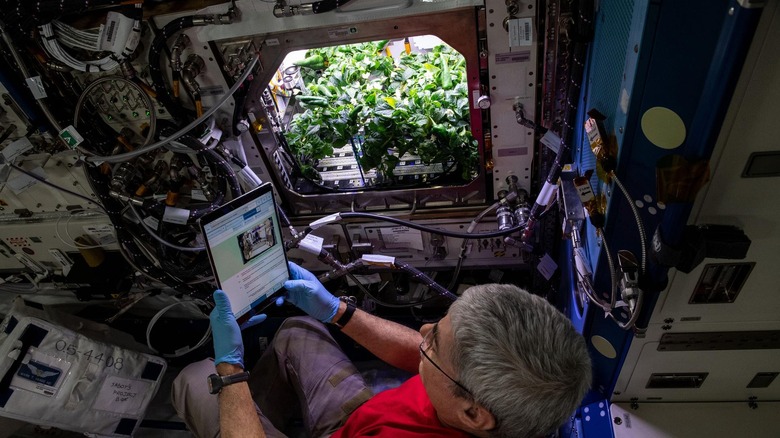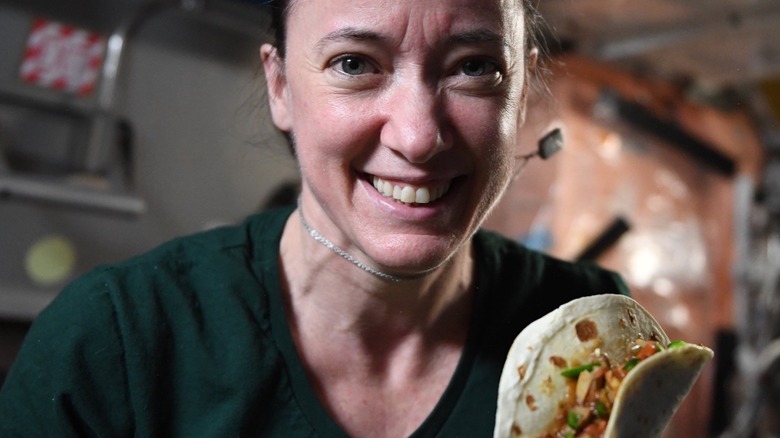The Fascinating Story Of NASA's Space Station Tacos
Astronauts have a long history of eating soft-shell tacos. Despite the fact that there have only been around 600 of them in all of human history, astronauts hold a handful of traditions, and tacos are probably the closest thing there is to traditional astronaut food. The reason is, surprisingly enough, tacos are an ideal space food.
Mealtimes aren't exactly the same in orbit, free from the clutches of gravity, and astronauts have a few extra worries to keep in mind. Crumbs, drifting weightlessly through the air, need to be avoided in case they clog instruments, and even a stray drop of tomato juice needs to be carefully chased down so it won't cause any problems later. Space tacos have the advantage of holding your dinner together in one place, with ingredients like leek cream to "glue" the contents together. Those ingredients, for the most part, are the same kind of rehydrated foods that are a typical part of an astronaut's diet in orbit — although, like on Earth, a dash of hot sauce is a popular addition.
In 2021, astronaut Megan McArthur sent a message from the International Space Station, reporting what she described as her "best space tacos yet." The ingredients, fajita beef and rehydrated vegetables, weren't too different to the usual fare, but these tacos had one exciting new addition: They included the first harvest of chile peppers grown right there in orbit!
Tortillas are a traditional astronaut staple
The first space foods were not particularly appetizing. Many of us have probably been to museums and seen what those early astronauts ate: plastic packets of semi-liquid foods, not entirely dissimilar to baby food, intended to be sucked up through straws. Other early space foods were simple freeze-dried cubes, intended to be rehydrated in the astronauts' own mouths. They provided sustenance, but not very much else. These foods eventually evolved into freeze-dried foods, prepared on Earth and flash-frozen in a vacuum to remove all the moisture. Essentially the same process is more familiar to most people as the way instant coffee granules are made.
Over time, as both astronauts and ground-based scientists gained experience, they began to send more and more interesting foods into orbit — particularly after NASA inaugurated the first space shuttle in 1981, giving spacefarers a much more roomy experience. Astronauts also had more freedom to request their own comfort foods to travel with and, in 1985, one astronaut requested a food that would one day become an outer space favorite.
Mexican payload specialist Rodolfo Neri Vela asked to bring the first tortillas into orbit with him. Being compact and shelf stable, and without the risk of potentially hazardous breadcrumbs, they quickly became popular among other spacefarers too. Essentially, any rehydrated food could be wrapped in a tortilla to make a quick and satisfying meal. Soon enough, NASA started regularly sending tortillas into space as astronaut food.
A healthy diet for the modern astronaut
The world's space agencies — particularly NASA, Roscosmos, ESA, and JAXA — all now have plentiful experience with what foods to send into orbit for their astronauts. Food in space has to be carefully chosen for space travel. After all, during a rocket launch, every single gram of weight can make a huge difference. NASA employs an entire team of food scientists for this important job, who consider things like nutritional value, ease of storage, and shelf life. Many astronaut foods are specially processed too, usually being irradiated or thermostabilised to kill off any bacteria and improve their shelf lives even further. With longer space journeys planned for the future, a good diet is increasingly on the minds of space agency mission planners, and some scientists have highlighted that a bland diet may be detrimental to astronaut morale.
All the while, tortillas are still one of the most convenient foods among astronauts, with tacos being a regular meal. ESA, the European Space Agency, has mentioned that astronauts like to refer to meals like these as "bonus food," with dishes that remind them of home cooking back down on Earth. Using tortillas to make both burritos and tacos is a favorite kind of bonus food on the International Space Station. The taco fillings in orbit may just be the same kind of pre-packaged food that astronauts usually eat, but a simple tortilla can transform it into something far more comforting.
Changing tastes in space
Being in microgravity has some strange effects on people's sense of taste, causing some space travelers to crave foods that they might not even eat on Earth. Without gravity, astronauts often find themselves feeling congested as their sinuses remain clogged with fluid that would usually drain away. With an impaired sense of smell, the flavor of food tends to be duller and more muted. The result is that astronauts often go for foods with strong flavors. Sweet, salty, and bitter foods are frequent choices, but by far the most popular thing among space travelers is spicy food!
With its sharp taste and spicy burn, a popular condiment in orbit is Tabasco sauce. As astronauts find their sense of taste less sensitive, the heat of the hot peppers starts to become a welcome replacement. The spice of chile peppers is not actually a taste. Unlike flavors like sour or sweet, it's an entirely different type of physical sensation; instead of coming from taste buds, the feel of spicy food comes from the molecule capsaicin stimulating nerve endings which usually respond to changes in physical temperature. Because the warmth of hot peppers isn't really affected by changes in an astronaut's sense of taste, spacefarers simply adore them. In 2002, astronaut Peggy Whitson even joked that she'd refuse to let a space shuttle crew onto the space station unless they'd brought a fresh supply of hot sauce. On future space stations, salsa and pepper sauce may be essential cuisine.
Space taco ingredients
Ironically, for astronauts, space is limited. The size and weight of things in storage need to be carefully considered, and properly maintaining food supplies is vital. Allowing food to go bad is absolutely unthinkable, being a waste on many different levels, and one of the best ways to keep space food fresh is to irradiate it.
While even the word "radiation" might make some people uncomfortable, this method is also used down here on Earth, with the EPA assuring people that irradiated foods are perfectly safe. The food is exposed to radiation that kills off the harmful bacteria which would usually make it go bad, but any radiation is long gone by the time it reaches the kitchen counter. For astronauts, irradiation is often used to ensure meat-based foods remain sanitary, with irradiated beef steak being among the items on the space station's menu. The exact system used by NASA for astronaut foods uses electron beams to sterilize food. It was carefully developed, and beef fajitas were used as a benchmark in early tests. In a sense, NASA's food sterilization is custom-made for Tex-Mex food.
Fajita beef and beef brisket are among the many things which NASA regularly sends into orbit for astronauts to eat in space. As well as tortillas, a few other Mexican foods are sometimes sent up too, like seasoned black beans. Taste testers often note, however, that even down on Earth, astronaut food will benefit greatly from a dash of hot sauce.
How to cook in orbit
The International Space Station doesn't really have a kitchen. It has a handful of galley areas, where some astronauts have enjoyed bonding over meals, but Earth orbit still doesn't have much in the way of home cooking — or even places to cook, for that matter. After all, most astronaut food is almost ready to eat, needing little more than rehydration.
The first true cooking in space was quite recent. At the end of 2019, astronauts baked cookies, using pre-made DoubleTree cookie dough and a specially designed oven. Actually cooking anything in space is a surprisingly difficult task. As well as the lack of gravity, there's a limited supply of power to use, and any excess heat inside spacecraft needs to be constantly radiated away into space to keep the environment safe for astronauts. The orbital baking was overseen by ESA astronaut Luca Parmitano, with the cookies taking over two hours to cook properly. Historic, but not exactly convenient.
In the future, it's likely that engineers will find more convenient ways to prepare food in space, perhaps allowing astronauts to use something more closely resembling an actual kitchen. When that happens, maybe astronauts will be able to make tacos using the first tortillas prepared fresh in space, rather than sending up pre-made flour tortillas from Earth. For now though, most space food is likely to remain pre-made, and trays of enchiladas are definitely not going to be on the menu anytime soon.
Sending groceries to orbit
Aboard the International Space Station, fresh foods are by far the most sought-after. After all, it's not like astronauts have a grocery store to go to. Fresh fruit and vegetables, like tomatoes and peppers, are a rarity in space. They don't stay fresh very long and, perhaps surprisingly, the space station doesn't have a fridge.
While it may not always be available, fresh produce is definitely high on the list of comfort foods for astronauts. Living in an entirely artificial environment, something as simple as an apple can provide an invaluable connection back to Earth — from the space station, our world is constantly visible but always out of reach. For this reason, fruit and vegetables are sent into orbit fairly regularly, particularly by JAXA, the Japanese Space Agency. Japan takes great care to select and package foods to send into orbit with their regular automated supply vessels. Russian astronauts, meanwhile, often bring tomatoes into orbit with them.
Actually eating these vegetables, however, is something that needs to be undertaken with a lot of care. While it may be tempting to bite directly into a fresh tomato or pepper, it's too risky in space. A single drop of fruit juice, drifting in the wrong direction, could have dangerous consequences if it lands on electronics. Any drop of stray fruit juice needs to be carefully tracked down and caught. As a result of all of this, space tacos aren't usually made with fresh ingredients.
Space veggies
The obvious way to provide a space station's inhabitants with fresh vegetables is to grow them in orbit. So NASA, being well aware of this fact, decided to try and do exactly that. There have now been several experiments on growing plants in orbit, and the first one was given the amusing codename of VEGGIE. First launched in 2012, the ultimate goal was to create a convenient supply of vegetables for astronauts in orbit. While fresh produce may have a limited shelf life, living plants can be much easier to maintain. In theory, fast-growing leafy greens like pak choi or lettuce would be easy to grow, and fruiting crops like tomatoes or beans could be grown in a 28-day cycle.
While the International Space Station may not have a sizeable vegetable garden just yet, some crops have already been grown up there. In 2014, astronauts cultivated the first ever space-grown salad vegetables, harvesting a crop of red romaine lettuce. The first batch was returned to Earth to check it was safe. After being given the all-clear from NASA scientists, astronauts grew more lettuce in 2015, eating it themselves this time (though no one seems to have mentioned whether or not anyone included it as a taco filling). Since then, more plants have been grown in orbit, and the experiments have become more ambitious. A challenging milestone was the Plant Habitat-04 study, which was the first attempt to grow chile peppers in space.
Hatch chiles
With chiles being so beloved by astronauts, attempting to grow them in orbit feels like an obvious choice. Pepper plants have the added bonus of being extremely easy to germinate down on Earth, making them a good choice of plant to try growing. These were the main focus of the Plant Habitat-04 experiment, with a collection of pepper plants grown in a small chamber aboard the International Space Station. The specific plants were Hatch chiles, a pepper cultivar from the Hatch Valley in New Mexico — though the name also works out as a pun, with the plants themselves being grown inside a small hatch.
Chile peppers, while easy to grow on Earth, were a more challenging crop in space. They need longer to germinate than lettuce or radish seeds, and take time before they produce anything edible. The experiment was a success though, with the first batch of chile peppers harvested in 2021 and enjoyed by the space station crew in tacos. They've also provided subsequent harvests since. The freshly grown chiles have reportedly helped improve the astronauts' sense of well-being, and the success of the experiment has given scientists enough information to grow more crops too. In 2023, a batch of tomatoes was harvested from space-grown plants, before being returned to Earth for testing. If all goes according to plan, maybe astronauts will soon enjoy fresh tomatoes in their tacos after all!
Tacos in space!
Megan McArthur's space tacos may not seem like much to us back here on Earth, but they're quite a milestone in space history. Most of the ingredients were standard astronaut fare, like fajita beef and rehydrated tomatoes and artichokes, but the ability to grow and harvest vegetables to add to their diets will likely be invaluable to future space travelers. With NASA currently planning crewed missions to the Moon, and long-term plans being made to establish a semi-permanent human presence there, a good supply of food is only going to become more important.
In the isolation of space, fresh foods will benefit both healthy diets and emotional well-being. What's more, the Hatch chiles have officially made history. In 2021, the pepper plants broke two records: for the longest-running experiment on the International Space Station, and for feeding the most astronauts from a crop grown in space. Not the first space crop, but probably the most satisfying to date! And the beauty of pepper plants is that they can keep on producing peppers for as long as they keep growing. With both spicy foods and tacos being so popular among astronauts, the Hatch chiles are likely to remain a popular space food in the future too.
The long tradition of tortillas
There's a kind of poetry in the story of astronauts eating tacos in Earth orbit. It's the continuation of a long, pre-Columbian food tradition. Tortillas have reportedly been eaten in Mesoamerica for at least 10,000 years, and the oldest evidence of domesticated chile peppers comes from Ecuador around 6100 years ago. Both of these are truly ancient foods and, championed by Mexican astronauts like José Hernández, they've now become an essential part of astronaut culture.
For the future, NASA scientists are considering alternative ways to produce food. One possibility is to use 3D food printers, creating specific dishes on demand, with custom-made flavors and textures. These are likely to work together with future space-grown vegetables too. There are already plans for how the spacefarers of the future may be able to grow vegetables in Earth orbit, and even in gardens on the Moon. While this may still be a long way into the future, achievements like growing and harvesting Hatch chiles in orbit are vital stepping stones on the road to getting there. Humans are still new to living off Earth, and as a regular part of astronaut diets, it's likely that tacos will continue to be eaten in space for some time still to come.
